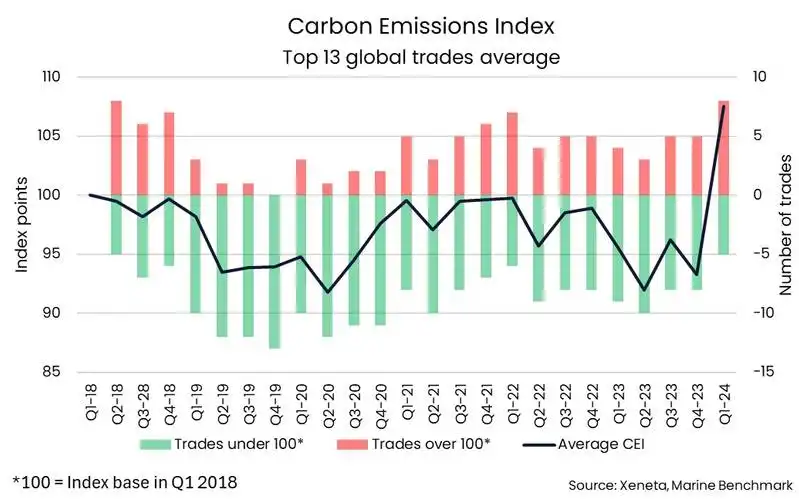Red Sea Conflict: Massive Carbon Emissions Increases
Conflict in Red Sea leads to significant carbon emissions increase in ocean freight container shipping, impacting supply chains and sustainability goals.
The conflict in the Red Sea has caused a significant increase in carbon emissions in ocean freight container shipping, as reported by Xeneta. The Xeneta and Marine Benchmark Carbon Emissions Index (CEI) reached 107.4 points in Q1 2024, the highest since the index's inception in Q1 2018.
The data shows a 63% increase in carbon emissions for containers shipped from the Far East to the Mediterranean in Q1 2024 compared to Q4 2023. Similarly, emissions rose by 23% for shipments from the Far East to North Europe. This spike is directly linked to the conflict in the Red Sea region, which has led to the avoidance of the Suez Canal by most container services due to security concerns.
Emily Stausbøll, a Xeneta Market Analyst, highlighted the environmental impact of the conflict, noting that ships are now traveling longer distances to avoid the Red Sea region. This has resulted in increased fuel consumption and higher carbon emissions. Additionally, some shippers have turned to air freight to maintain supply chains, further contributing to carbon emissions.
The shift towards air freight and rail services through Russia is not only more expensive but also less sustainable than ocean freight. This change in transportation modes is expected to lead to a rise in carbon emissions per ton of cargo transported. The situation underscores the significant impact that conflict can have on carbon emissions and climate change.
The timing of these developments is crucial, as the International Maritime Organization (IMO) is striving for net zero emissions in global ocean freight shipping by 2050. The introduction of EU-ETS regulations in 2024, which require ocean freight providers to pay subsidies based on carbon emissions, further highlights the need for sustainable practices in the industry.
Despite the IMO's focus on carbon intensity rather than actual emissions, the longer sailing distances resulting from the conflict in the Red Sea region will undoubtedly impact sustainability efforts. This, in turn, will lead to increased costs for ocean freight carriers, who may pass these expenses on to businesses through higher shipping rates or surcharges.
As global conflicts and crises become more frequent, the challenge for the ocean freight industry is to balance supply chain security with environmental sustainability. Finding solutions to reduce carbon emissions while maintaining efficient transportation routes will be crucial in meeting emission targets and ensuring a sustainable future for global shipping.












Comments on Red Sea Conflict: Massive Carbon Emissions Increases